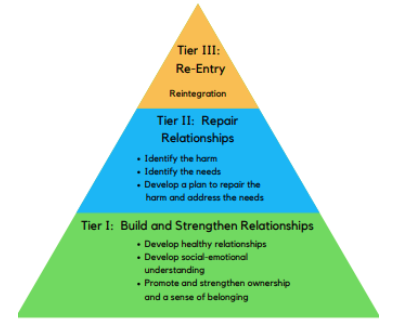
The Restorative Justice Whole School Approach image demonstrates three levels of school engagement. When staff and teachers make a commitment to intentionally and thoughtfully engage in all three levels, schools see the following dramatic changes:
- Relationships improve between adults, between students and between adults and students.
- Adults and students experience an increased sense of belonging.
- Suspension and expulsion rates are lowered.
- Everyone experiences an increased engagement and ownership.
- Everyone is involved in shifting how they engage in relationships with one another and how they think about community.
Tier 1: Build and Strengthen Relationships
Tier 1 is characterized by building and strengthening relationships which leads to fewer breakdowns in communication. Building a strong foundation of trust helps the community address and deal with harm and conflict restoratively. Daily/weekly classroom community building circles and restorative conversations develop positive relationships, develop social-emotional learning and promote and strengthen a sense of belonging and ownership within the school community.
Tier 2: Repair Relationships
Tier 2 is characterized by utilizing non-punitive responses to addressing harm and conflict. Practices, such as repairing harm circles, family group conferencing and conflict mediation, allow participants to positively address harm and disciplinary issues. These practices also allow adults to resolve conflict restoratively and reach consensus on how all parties will interact moving forward. Ultimately, repairing relationships is the process of identifying the harm, acknowledging the needs of all parties involved, finding the root causes of the behavior and developing a plan to address the needs and the harm, so everyone moves forward in a good way.
Tier 3: Re-entry
Tier 3 is characterized by providing individualized support to students, who return to the district after being incarcerated, expelled, suspended or placed in an alternative placement. The student and family receive the necessary support to create a successful reintegration to their school. The student is welcomed back into the school community in a restorative manner that provides responsibility, accountability and opportunities to experience a sense of belonging.

